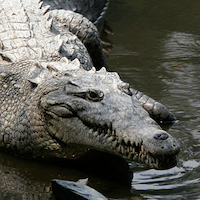Population status of the American crocodile, Crocodylus acutus (Reptilia: Crocodylidae) and the spectacled caiman, Caiman crocodilus (Reptilia: Alligatoridae) in the Costa Rican North Caribbean

Accepted: 22 September 2021
HTML: 3
All claims expressed in this article are solely those of the authors and do not necessarily represent those of their affiliated organizations, or those of the publisher, the editors and the reviewers. Any product that may be evaluated in this article or claim that may be made by its manufacturer is not guaranteed or endorsed by the publisher.
Along the Costa Rican Caribbean shoreline, it is possible to find two species of crocodilians, the American crocodile (Crocodylus acutus) and the spectacled caiman (Caiman crocodilus). This region can be divided geographically into three subregions: North, Central, and South Caribbean. We conducted this research in the North Caribbean, between October 6, 2018 and August 31, 2019. Specifically, we worked in the area lying between the Jalova Station of the Tortugero National Park (TNP) and Agua Dulce Lake situated in the northern tip of Machuca Island, at the mouth of the Colorado River inside the Barra del Colorado National Wildlife Refuge (BACORE), which includes other connecting wetlands as well (Sierpe River, Samay Lake). Overall, this study area had an approximate extension of 408 km2 characterized by large, wide and deep canals, as well as wetlands, meanders, and adjacent lakes. The sampling was performed along 10 segments that varied in length from 7.5 km up to 29.49 km, located in the nearby zones of TNP and BACORE. In these zones, nightly counts were carried out using dazzling lamps. Individuals of C. acutus and C. crocodilus were classified into eight and six body size classes, respectively (both with 50 cm intervals). A relative abundance of 0.55 crocodiles and 1.37 caimans per linear kilometer was estimated during these spotlight surveys. The capture of 39 caimans let us to estimate a ratio of 30 males to 9 females (3.3:1 M:F). In stark contrast, only 1 male and 1 female crocodile were captured. A total of 85 C. acutus and 205 C. crocodilus were observed. Regarding the number of caiman sightings in the TNP, a statistically significant difference was found (Χ2=5.62, p≤0.05) for the distribution by sizes between the zones of BACORE and TNP, whereas no such difference was found for C. crocodilus sightings (Z=–1.22, p≥0.222). Some segments had a higher probability of caiman occurrence than did others in the surveys performed during the monitoring period (X2=8.36, p≤0.05), especially the Jalova-Sierpe River, Caño Negro-Tortuguero, and Tortuguero-Samay Lake (Tortuguero subarea) segments. Ninety percent of the sightings occurred in the BACORE zone, and this was significantly different (Χ2=7.34, p≤0.026) from the studied subareas. The number of crocodile sightings in the Colorado River segment was significantly different and higher than the other segments (X2=7.28, p≤0.05). There was a significant statistical difference among the sizes in all areas of study (X2=5.529, p≤0.026). The abundance of C. acutus and C. crocodilus in the north Caribbean part is lower than in the central Caribbean part of Costa Rica, where this species could use the resources available in more urbanized areas.
PAGEPress has chosen to apply the Creative Commons Attribution NonCommercial 4.0 International License (CC BY-NC 4.0) to all manuscripts to be published.


 https://doi.org/10.4081/tz.2021.77
https://doi.org/10.4081/tz.2021.77



